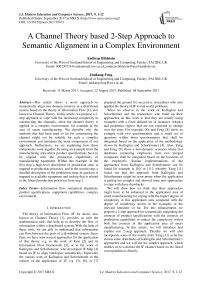A Channel Theory based 2-Step Approach to Semantic Alignment in a Complex Environment
Автор: Andreas Bildstein, Junkang Feng
Журнал: International Journal of Modern Education and Computer Science (IJMECS) @ijmecs
Статья в выпуске: 9 vol.9, 2017 года.
Бесплатный доступ
This article shows a novel approach to semantically align two domain contexts in a distributed system based on the theory of Information Flow [1], also known as Channel Theory. In this article, we propose a 2-step approach to cope with the increasing complexity in constructing the channels, when the channel theory is applied in a complex environment, for example in the area of smart manufacturing. We describe why the methods that had been used so far for constructing the channel might not be suitable for such a complex environment and introduce the main components of our approach. Furthermore, we are explaining how these components work together by using an example from the manufacturing area where product specifications have to be aligned with the production capabilities of manufacturing equipment. Within this example, in the first step a high-level description of production steps is mapped to production processes, and in the second step, a detailed description of the production steps in question is mapped to available equipment and tooling that is related to the filtered production processes from step 1.
Information flow, semantical alignment, product specifications, equipment capabilities, complex environment
Короткий адрес: https://sciup.org/15014997
IDR: 15014997
Список литературы A Channel Theory based 2-Step Approach to Semantic Alignment in a Complex Environment
- J. Barwise and J. Seligman, Information Flow: The Logic of Distributed Systems, Reprinted. New York: Cambridge University Press, 1997.
- R. E. Kent, “The Information Flow Foundation for Conceptual Knowledge Organization,” in Sixth International Conference of the International Society for Knowledge Organization, 2000.
- R. E. Kent, “Semantic Integration in the Information Flow Framework,” Dagstuhl Seminar Proceedings 04391, pp. 1–12, 2005.
- Y. Kalfoglou and M. Schorlemmer, “IF-Map : An Ontology-Mapping Method based on Information-Flow Theory,” Journal on Data Semantics, vol. 1, no. 1, pp. 98–127, 2003.
- Y. Kalfoglou and M. Schorlemmer, “Information-Flow-based Ontology Mapping,” in On the Move to Meaningful Internet Systems, 2002 - DOA/CoopIS/ODBASE 2002 Confederated International Conferences DOA, CoopIS and ODBASE 2002, 2002, pp. 1132–1151.
- M. Schorlemmer and Y. Kalfoglou, “Using Information-Flow Theory to Enable Semantic Interoperability,” in Artificial Intelligence Research and Development, 2003, pp. 1–6.
- M. Schorlemmer and Y. Kalfoglou, “Progressive Ontology Alignment for Meaning Coordination: an Information-Theoretic Foundation,” Knowledge Creation Diffusion Utilization, pp. 737–744, 2005.
- K. Xu and J. Feng, “An information flow based approach to finding informational relationships between questionnaires,” IET International Conference on Information Science and Control Engineering 2012 (ICISCE 2012), p. 1.04-1.04, 2012.
- G. Yang and J. Feng, “Database Semantic Interoperability based on Information Flow Theory and Formal Concept Analysis,” International Journal of Information Technology and Computer Science, vol. 4, no. 7, pp. 33–42, Jul. 2012.
- R. Mantri, “Database Web Service Composition based on the Notion of ‘Informational Relationship,’” Doctoral Thesis, University of the West of Scotland, 2013.
- G. Yang, “Achieving Database Semantic Interoperability with a Perspective of Information Flow and Formal Concepts,” Doctoral Thesis, University of the West of Scotland, 2015.
- X. Xu, “From cloud computing to cloud manufacturing,” Robotics and Computer-Integrated Manufacturing, vol. 28, no. 1, pp. 75–86, Feb. 2012.
- D. Wu, M. J. Greer, D. W. Rosen, and D. Schaefer, “Cloud manufacturing: Strategic vision and state-of-the-art,” Journal of Manufacturing Systems, pp. 1–16, May 2013.
- Y. Kalfoglou and M. Schorlemmer, “Formal Support for Representing and Automating Semantic Interoperability,” in The Semantic Web: Research and Applications: First European Semantic Web Symposium, ESWS 2004, 2004, pp. 45–60.
- DIN8580:2003-09, “Manufacturing processes – Terms and definitions, divisions“ (org. “Norm DIN 8580:2003-09, Fertigungsverfahren - Begriffe, Einteilung”), Beuth Verlag GmbH, Berlin.


